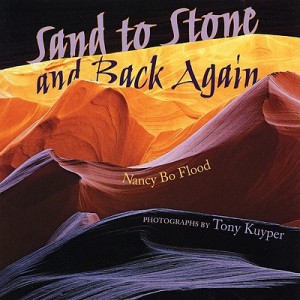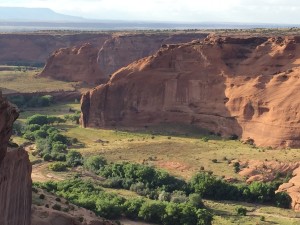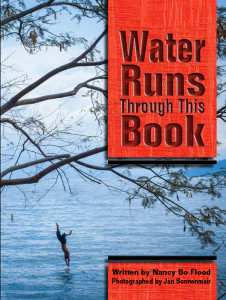Nancy Bo Flood is the author of many books, including Sand to Stone and Back Again, Cowboy UP – Ride the Navajo Rodeo, and most recently, Water Runs Through This Book, with photos by Jan Sonnenmair. Today, she’s stopped by ReaderKidZ to talk about her newest book. Leave a COMMENT below and be entered for a chance to WIN A COPY.
RKZ: Water Runs Through This Book covers a lot of territory in 64 pages. From the first chapter, “You Are Water” to the final, “Going, Going… STOP!” you remind readers that not only is water necessary to keep our bodies “alive, fueled, and healthy,” but that each one of us must take the job of water conservation seriously. It’s as a timely a message now as ever. Can you talk about the genesis of the book and how you’d like to see teachers using it in classrooms?
NBF: “Will this rain storm end the drought?” I stood on a sandstone cliff watching rain pour down a thousand feet, forming instant waterfalls that crashed into nearly empty pools below. Rain was finally falling after many dry months of nothing.
“No” was the simple reply of the hydrologist.
I stared at her, not quite believing her answer. “But we’ve gotten three inches of rain in the last 24 hours.”
“This sandstone will soak up every drop. Almost nothing will trickle down past shrub roots. It’s been a long drought. Even the rocks are thirsty.”
That image of our earth, the high desert of the southwest – where even the rocks were thirsty – kept haunting me. A couple of years ago I was talking to teachers about the cycle of sandstone (Sand to Stone and Back Again) and the continued interconnections between earth, sky, sea. The teachers asked, what about water? How can we teach about water? When iUtah asked me to write a book about water, I thought about the thirsty rocks, the need to conserve and protect water, and said “Yes.”
 RKZ: One of the most powerful chapters for me was “Making Supper and Shoes.” Statistics such as the fact that manufacturing a shirt uses about 700 gallons of water and that it takes about 4,000 to 18,000 gallons to “grow the cow” that will eventually become a thick, juicy hamburger lunch puts things in perspective in a way that kids can relate to. I can imagine the book inspiring all sorts of additional classroom research and projects. What are your 3 favorite water-saving tips that young readers can implement starting today? What’s one additional tip that readers may not have considered?
RKZ: One of the most powerful chapters for me was “Making Supper and Shoes.” Statistics such as the fact that manufacturing a shirt uses about 700 gallons of water and that it takes about 4,000 to 18,000 gallons to “grow the cow” that will eventually become a thick, juicy hamburger lunch puts things in perspective in a way that kids can relate to. I can imagine the book inspiring all sorts of additional classroom research and projects. What are your 3 favorite water-saving tips that young readers can implement starting today? What’s one additional tip that readers may not have considered?
NBF: Turn off the faucet – when brushing teeth, washing your face, or in the kitchen, fixing a snack or cleaning up. In the past ten years kids and families in the U.S. significantly reduced water usage. Let’s continue that!
Here is a fun challenge: have a “faucet” day. Most Americans use over 100 gallons of water daily.
Fill up 20 empty plastic milk gallons with water. Use an outside hose and carry the water jugs to the bathroom. How long did that take? Stack up the jugs in the bathtub or shower. Each time you turn on the faucet, figure out how much water you use. Put a pan or basin under the faucet. Keep a tally. See if you can use less than 20 gallons. Remember to count washing clothes, washing you, using the dishwasher, and flushing the toilet (2-7 gallons!).
It would be interesting for a classroom of kids to compute their one-day water usage. How long did it take to carry that much water one block (from “well” to school?). Share ideas about how to use less water. Use your collective, creative brain – it’s 90% water!
RKZ: Thanks, Nancy, for sharing your latest book and reminding us all of the many small ways we can make a difference conserving one of our most important resources – water.
Learn more about Nancy Bo Flood on her website.
Check out other ReaderKidZ reviews of Nancy’s books:
COWBOY UP!:Ride the Navajo Rodeo by Nancy Bo Flood, photographs by Jan Sonnenmair
SAND TO STONE AND BACK AGAIN by Nancy Bo Flood, photographs by Tony Kuyper
THE HOGAN THAT GREAT GRANDFATHER BUILT by Nancy Bo Flood, illustrated by Peterson Yazzie.











What a wonderful post. Nancy’s skills at covering nonfiction topics while making them interesting combined with her creative ability to make words dance on the page and engage the reader is amazing. Her newest book on water should be in every intermediate and middle grade classroom as it fits so well with the common core and pieces together the common and uncommon facts about earth’s most precious resource!
Thank you, Diane, a wonderfully creative and dedicated teacher, author, and artist. I appreciate your words and encouragement. We all need to become more informed and aware of this life-giving resource, water.